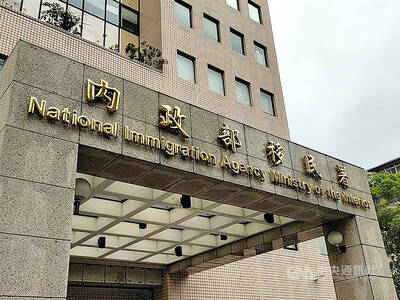Environmental groups yesterday called for stricter standards for environmental impact assessments (EIAs), saying that loosening requirements for solar projects could damage the environment.
The Ministry of Environment yesterday discussed draft amendments to the Standards for Determining Specific Items and Scope of Environmental Impact Assessments for Development Activities (開發行為應實施環境影響評估細目及範圍認定標準), with a focus on the assessment standards for photovoltaic development on hillsides and in environmentally sensitive areas, such as wetlands, intertidal zones, nature reserves and state plantations.
Environmental groups and the Government Watch Alliance held a news conference in front of the ministry before the discussion, saying that current standards lack an awareness of conservation and that EIAs are necessary.

Photo: CNA
The ministry should conduct at least four public hearings around Taiwan to reach a consensus among stakeholders, Government Watch Alliance spokesperson Chen Jiau-hua (陳椒華) said.
The draft amendments state that photovoltaic development projects covering an area less than 15 hectares would be exempted from EIAs and do not stipulate that a developer cannot apply for development permits under different company names, she said, adding that it would result in developers splitting the land into smaller pieces to evade EIAs.
The 15-hectare threshold is unreasonable, as pastures and campsites larger than 1 hectare are required to undergo assessments, City Forest Association, Taiwan chairman Chuang Chieh-jen (莊傑任) said.
Leopard Cat Association of Taiwan member Chen Chi-chung (陳祺忠) agreed that the threshold is not strict enough and suggested tightening assessment standards for photovoltaic development not only on hillsides, but also on non-urban land and regular agricultural districts.
Assessments should be mandatory for projects covering an area of 2 or more hectares on national or public land and land owned by state-owned or public companies, as these lands are currently exempted with approval from energy authorities, Chuang said.
Those covering less than 2 hectares should be exempted only if they are approved by forestry authorities — instead of energy authorities — to curb improper development of state plantations, he said, adding that it is unrealistic to expect energy authorities to impose tight controls.
Photovoltaic development in intertidal zones should be subject to EIAs regardless of scale, as most are important habitats for birds, Changhua Environmental Protection Union representative Jenny Wu (吳慧君) said.
The number of endangered bird species inhabiting the coastal wetlands in Changhua County dropped from 23 in 2019 to 12 in 2021, after a wind power development began in 2019 without doing EIAs and installed 14 turbines within 2.5km, she said.
The ministry would discuss whether to impose EIAs on smaller scale projects and those in intertidal zones, Department of Environmental Protection Director-General Tsai Meng-yu (蔡孟裕) said.
Photovoltaic development do not cause air and water pollution, and the amendments aim to resolve EIA-related issues based on regulations in other countries, he said, adding that developments covering an area less than 40 hectares are exempted in Japan.
Additional reporting by CNA

CAUTION: Based on intelligence from the nation’s security agencies, MOFA has cautioned Taiwanese travelers about heightened safety risks in China-friendly countries The Ministry of Foreign Affairs (MOFA) yesterday urged Taiwanese to be aware of their safety when traveling abroad, especially in countries that are friendly to China. China in June last year issued 22 guidelines that allow its courts to try in absentia and sentence to death so-called “diehard” Taiwanese independence activists, even though Chinese courts have no jurisdiction in Taiwan. Late last month, a senior Chinese official gave closed-door instructions to state security units to implement the guidelines in countries friendly to China, a government memo and a senior Taiwan security official said, based on information gathered by Taiwan’s intelligence agency. The

Taiwan Semiconductor Manufacturing Co (TSMC), the world’s largest contract chipmaker, said yesterday that it is looking to hire 8,000 people this year, at a time when the tech giant is expanding production capacity to maintain its lead over competitors. To attract talent, TSMC would launch a large-scale recruitment campaign on campuses across Taiwan, where a newly recruited engineer with a master’s degree could expect to receive an average salary of NT$2.2 million (US$60,912), which is much higher than the 2023 national average of NT$709,000 for those in the same category, according to government statistics. TSMC, which accounted for more than 60 percent

The National Immigration Agency (NIA) said yesterday that it will revoke the dependent-based residence permit of a Chinese social media influencer who reportedly “openly advocated for [China’s] unification through military force” with Taiwan. The Chinese national, identified by her surname Liu (劉), will have her residence permit revoked in accordance with Article 14 of the “Measures for the permission of family- based residence, long-term residence and settlement of people from the Mainland Area in the Taiwan Area,” the NIA said in a news release. The agency explained it received reports that Liu made “unifying Taiwan through military force” statements on her online

Tung Tzu-hsien (童子賢), a Taiwanese businessman and deputy convener of the nation’s National Climate Change Committee, said yesterday that “electrical power is national power” and nuclear energy is “very important to Taiwan.” Tung made the remarks, suggesting that his views do not align with the country’s current official policy of phasing out nuclear energy, at a forum organized by the Taiwan People’s Party titled “Challenges and Prospects of Taiwan’s AI Industry and Energy Policy.” “Taiwan is currently pursuing industries with high added- value and is developing vigorously, and this all requires electricity,” said the chairman